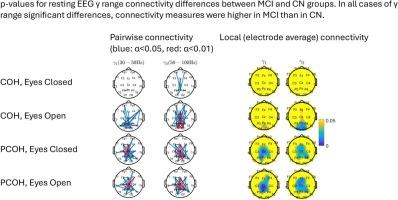静息脑电图部分相干性显示遗忘性轻度认知障碍患者γ范围中枢功能连通性增加。
IF 2.6
4区 医学
Q3 NEUROSCIENCES
引用次数: 0
摘要
目的:对阿尔茨海默病(AD)脑电图高γ (gamma)范围变化的了解相对较少。我们使用普通相干性(COH)和部分相干性(PCOH)研究了遗忘性轻度认知障碍(MCI)的功能连通性,重点是γ范围,PCOH是一种提高高频信噪比的指标。方法:MCI (N=21)和认知正常(N= 62) ALBION研究参与者在10/20蒙太奇(19个活动电极)中闭眼(EC)和睁眼(EO)静息EEG。计算所有171对电极在0.5 ~ 100 Hz范围内每个受试者的COH和PCOH。结果:在γ -1(30-50 Hz)和γ - 2(50-100 Hz)范围内,MCI的PCOH明显高于CN,在两种眼睛条件下,在几个电极对中,特别是中央。在局部(每个电极的平均值)连通性方面,MCI在PCOH的中心值明显高于CN。结论:PCOH显示,MCI患者的静息EEG γ范围中枢功能连通性明显高于CN。意义:γ范围局部和区域脑电图功能连接差异可能有助于构建有用且易于获得的神经变性生物标志物。度量,如PCOH,可以分解出全局连接组件,可能有助于揭示这些差异。本文章由计算机程序翻译,如有差异,请以英文原文为准。

Resting EEG partial coherence demonstrates increased γ range central functional connectivity in amnestic mild cognitive impairment
Objective
Relatively little is known about EEG high (gamma) range changes in Alzheimer’s disease (AD). We investigated functional connectivity, focusing on the range, in amnestic Mild Cognitive Impairment (MCI) using ordinary Coherence (COH) and Partial Coherence (PCOH), a metric which enhances signal to noise ratio at high frequencies.
Methods
MCI () and Cognitively normal (CN, ) ALBION study participants had resting EEG with eyes closed (EC) and eyes open (EO) in 10/20 montage (19 active electrodes). COH and PCOH in 0.5–100 Hz for each subject were calculated for all 171 electrode pairs.
Results
In both (30–50 Hz) and (50–100 Hz) ranges, PCOH was significantly higher in MCI than in CN in several electrode pairs, especially centrally, in both eye conditions. Concerning local (average of each electrode) connectivity, MCI compared to CN showed significantly higher values in PCOH centrally.
Conclusions
Resting EEG range functional connectivity at central areas, as revealed by PCOH, is significantly higher in MCI than in CN.
Significance
range local and regional EEG functional connectivity differences may help construct useful and easily available biomarkers in neurodegeneration. Metrics, such as PCOH, which factor out global connectivity components may help reveal such differences.
求助全文
通过发布文献求助,成功后即可免费获取论文全文。
去求助
来源期刊

Brain Research
医学-神经科学
CiteScore
5.90
自引率
3.40%
发文量
268
审稿时长
47 days
期刊介绍:
An international multidisciplinary journal devoted to fundamental research in the brain sciences.
Brain Research publishes papers reporting interdisciplinary investigations of nervous system structure and function that are of general interest to the international community of neuroscientists. As is evident from the journals name, its scope is broad, ranging from cellular and molecular studies through systems neuroscience, cognition and disease. Invited reviews are also published; suggestions for and inquiries about potential reviews are welcomed.
With the appearance of the final issue of the 2011 subscription, Vol. 67/1-2 (24 June 2011), Brain Research Reviews has ceased publication as a distinct journal separate from Brain Research. Review articles accepted for Brain Research are now published in that journal.
 求助内容:
求助内容: 应助结果提醒方式:
应助结果提醒方式:


